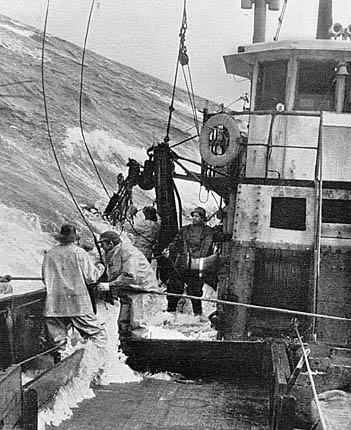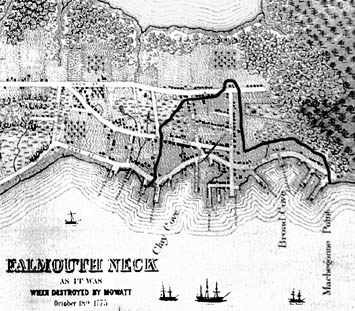Walking the Plank
by Paul Molyneaux
| |
After seven years of regulatory
hardball, most groundfish stocks are all rebounding. Gray sole, and Georges Bank yellowtail stocks have been rebuilt, and the aggregate biomass of 11 important stocks including Georges Bank haddock, has grown more than two and a half times since 1994. Fishermen and fleet owners who survived Amendments 5 and 7, have learned to live with the tough regulations that led to the current recovery, and now see a light at the end of the tunnel.
"My husband's been fishing for 30 years and he says things are looking good out there," said Portland-based fishermen's representative, Maggie Raymond.
In spite of the great gains, the upcoming amendment to the Multispecies Fisheries Management Plan will impose more restrictions.
"It's time to feel good about where we are," said NEFMC executive director, Paul Howard, speaking at the Maine Fishermen's Forum in Rockport. "Stocks are rebuilding extremely nicely , 15 to 17 percent every year since Amendment 5 [1994]. Is it time to celebrate? No, because we're only half way there, and we still have half way to go."
Amendment 13, the first amendment to the multispecies plan that will address the requirements of the 1996 Sustainable Fisheries Act (SFA), fell behind schedule this winter. The NEFMC planned to introduce proposals for Amendment 13 at its
|
 |
|
March 13-14 meeting in New London, Connecticut, but had to postpone that phase until May. Nonetheless, Howard shared some information about the new plan at the March 3 meeting at the Forum.
Howard, pointed out that in the late 80s and early 90s, fishermen were harvesting 3 out of 5 fish , 60 percent of the available resources , and that had to change. "We need to recognize that sustainable fisheries means keeping 4 out every 5 fish in the ocean. When you harvest only 1 out of 5 fish, stocks grow, and landings increase," he said. "That's the whole goal of Amendment 13; build the biomass, get increased catches."
|
Deep Cuts
In order to meet the SFA requirements for rebuilding of overfished stocks and ending overfishing, Amendment 13 will include further reductions in fishing mortality. Howard informed listeners that the Council will be looking for a 65 percent reduction in fishing mortality for southern New England and mid-Atlantic yellowtail; 37 percent for Georges Bank haddock; 60 percent for white hake; 30 percent for dab. The status of Gulf of Maine cod remains uncertain. "We'll be doing a new benchmark assessment on cod this spring and we'll know more then," said Howard.
continue
|
|
Fight or Be Slaves
by Mike Crowe
| |
In 1775 Falmouth was a town of one, two and three story wood buildings. The center of town was on Falmouth Neck, a narrow peninsula that is today downtown Portland. Most of the buildings, painted and not, commercial and residential, were clustered on the hill behind the wharfs along Fore Street, the waterfront at the time. The few streets in town were dirt, including Back Street, now Congress Street, which marked the westerly edge of development. From this high point down to Back Cove were woods and fields.
continue
|

| |
This map, made in the 1830s, was based on a map made nine months after the burning of Falmouth. That map, known as the "Pointer Draft," was used by Falmouth in an attempt to get reparations. The map above is not considered to be accurate in either scale or the number, size and placement of buildings. It does show the concentration of buildings and the area completely destroyed. Lost and Found: the "Pointer Draft" of Falmouth in October, 1775, by Charles P.M. Outwin, copyright 2000.
|
  
©2001 solution3d
|
|

